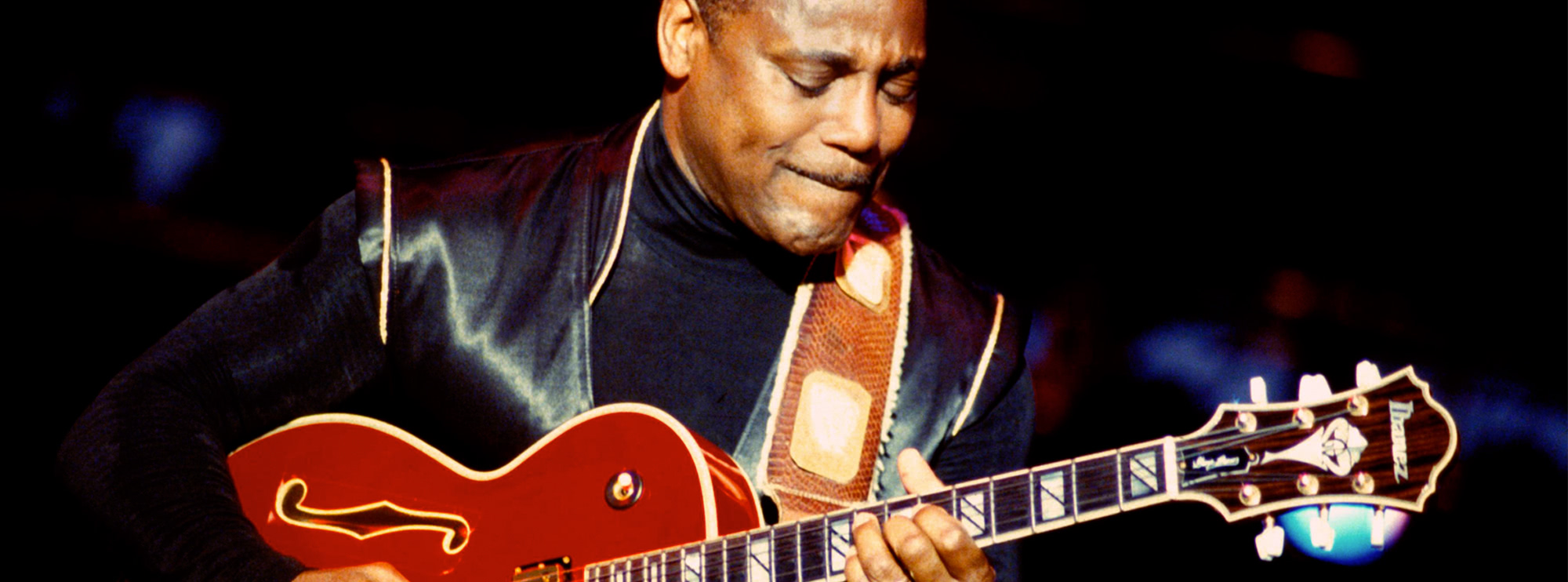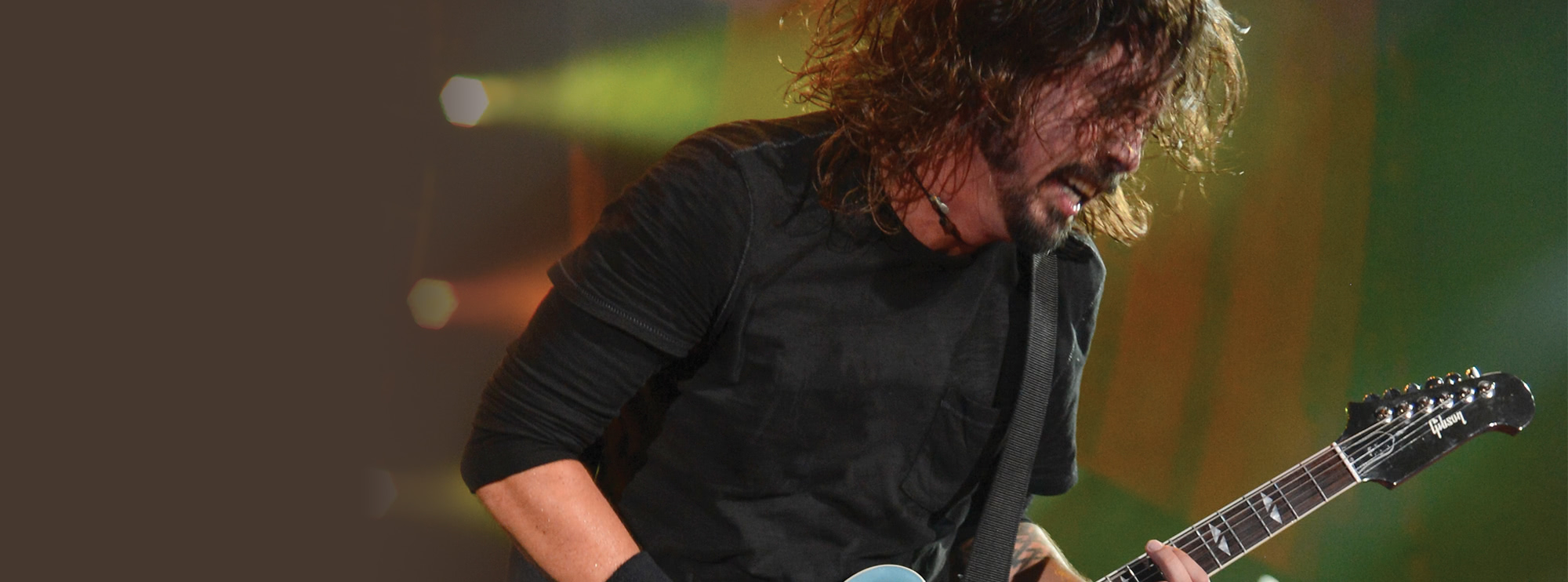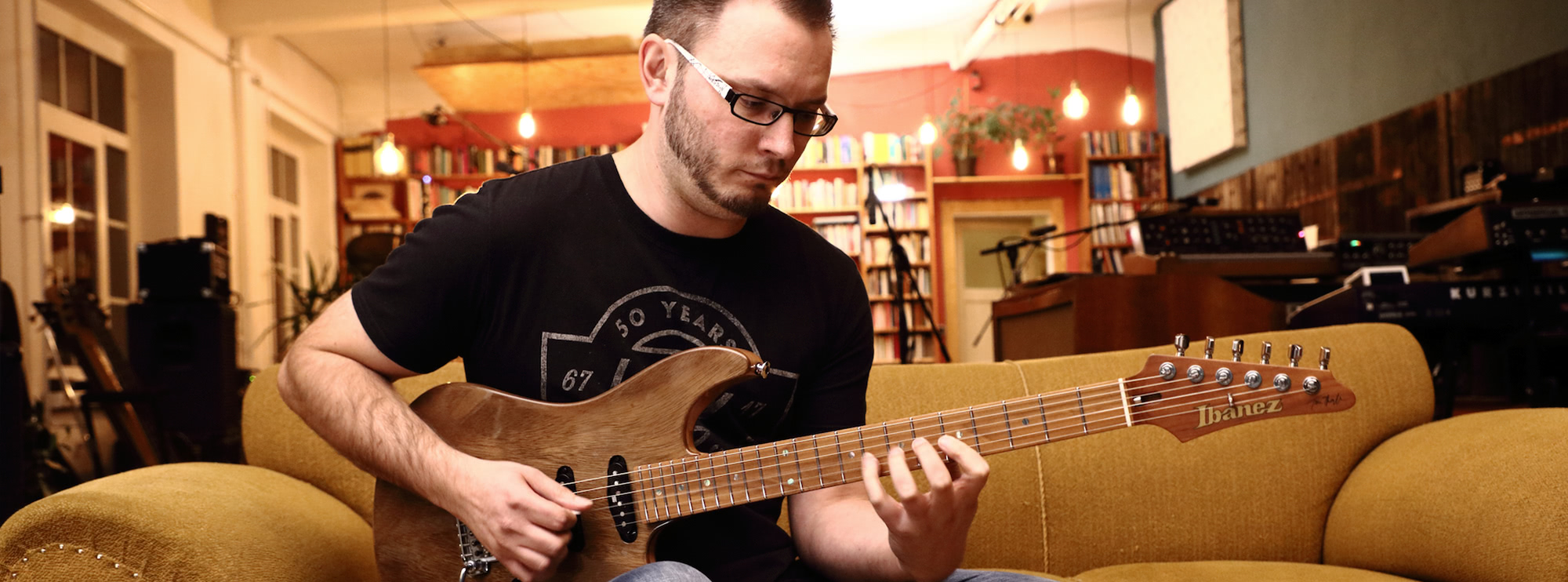Petrucci calls his influences "the Steves and the Als" (namely Steve Howe, Steve Vai, Steve Morse, Alex Lifeson, Al Di Meola and Allan Holdsworth). Still, his rhythm work owes as much to James Hetfield's ferocious riffing style as anyone else. It's undoubtedly this blend of crushing riffs and virtuosic lead work that is responsible for his ascendency to metal godhood. In this tech session, we're going to try and touch on all of these elements. But first, let's talk tone.
THE GEAR:
As multifaceted and complex as John Petrucci's playing style is, his approach to tone is very simple and refined. Petrucci mainly uses three core tones:
i) A high headroom, effects-laden clean
ii) A tight, dry and scooped rhythm tone
iii) A smooth and saturated lead tone
A long-time champion of Mesa/Boogie's Mark series of amps (which I myself am also a huge fan of), Petrucci's signature JP2C head has a channel for each of these jobs, but once upon a time it took a huge rack and at least three amp heads to achieve a setup like this. This "three core tones" approach is one many metal players use to this day, and we can thank John Petrucci for popularising it.
Interestingly, this tonal approach goes beyond the amp and effects and is actually hard-baked into Petrucci's guitars. Even back in his Ibanez JPM days, Petrucci favoured guitars loaded with two very different sounding humbuckers and a three-way toggle, yielding - you guessed it - three distinct tones:
i) Both pickups with coil splits for clean
ii) A tight and aggressive bridge pickup for rhythm
iii) An articulate and flutey neck pickup for lead
Yes, there's a pickup selection for each tone, and this is an approach that Petrucci almost never deviates from. What this means is that each pickup is designed for one specific job, and each selection almost sounds like picking up a different guitar!
For this tech session, I used a 2019 Monarchy Majesty (kindly loaned to us by Ernie Ball UK) loaded with DiMarzio Sonic Ecstasy humbuckers pretty much exactly as described above, along with the under-saddle piezo pickup for some of the cleaner parts. I plugged it into my old faithful '90s Mesa/Boogie Mark IV, using the "Rhythm 1" channel for cleans and "Lead" channel for both rhythm and leads - using a more aggressive scoop on the graphic eq for the rhythm tones.
One of the unique features of Mark series amps is the position of the tone stack. The treble, middle and bass controls are all pre-gain, meaning they affect your tone going into the amp's distortion - the opposite of almost every other high gain amp in the world. With this configuration, it's possible to roll the bass control all the way to zero to "tighten up" the distortion, then add back the lost low end using the graphic EQ. The result is a super fast and articulate sound that can be a little unnerving at first, but once you get used to it you'll notice how accurately it tracks complex lines. If you don't have a Mark series amp, you can emulate this setup using an EQ pedal in front of your amp to roll off everything under around 100hz, and adding it back with the amp's bass control.
Petrucci does tend to boost his lead tones with an overdrive pedal, but the Majesty guitar I used comes with a built-in 20db boost that did a great job of adding some more saturation and compression to lead lines. I also flattened out the graphic EQ a little for the leads and added some more EQ and some reverb and delay in post.
With that, let's get stuck in!
BARS 1-8: Kicking off with a clean passage, and of course, we're in odd time - 5/4, to be precise. Keep your foot tapping throughout this and you should be fine, but don't worry if you have to count 1-2-3-4-5 aloud - there's no rhythm section to keep you in time just yet. Try to keep the open strings ringing throughout.
BARS 9-15: Switching quickly to a heavy rhythm sound on the bridge pickup, we have some wide-open chord stabs. These wide interval "stacked 5th" chords are very common in Petrucci's rhythm work because they don't get as "muddy" as close voiced chords with lots of distortion. The first one is an Esus2 (implying Em9), the second one is an A7/E. Be careful with the timing of the stabs - the Esus2 stabs on beats 4 and 5, while the A7/E is one beat later on beats 5 and 1.
BAR 16: Time for the first shred lick of the session, and it's a doozy - a blazing unison with the synth lead that uses the whole kitchen sink of techniques, and as if that wasn't bad enough it all happens over a time signature change! The initial legato phrase gives way to some slippery Steve Morse-inspired cross-picking that'll challenge your pick hand control - use a shallow curved pick motion so that both strokes can clear the strings without too much-wasted motion.
It's followed by a sextuplet pattern that uses downward pick slanting to maintain the straight alternate picking that Petrucci is known for. For this, slightly supinate your hand so that alternate picking in a straight line makes the upstrokes rise above the strings without worrying too much about the downstrokes. To be strictly authentic, you should switch to your neck pickup for this line, but if that's too much to handle (understandably), feel free to stay on the bridge pickup until you crack this lick.
BARS 17-25: We're back with the chunky riffs, this time in 3/4 time. If you'd switched to your neck pickup for the previous line, you can chug the first three open E notes and quickly switch to the bridge pickup before the stretchy chords.
You'll need to be pretty deft with your palm muting to get the articulation right on these chords, but be careful not to "tighten up" too much - you'll need to stay loose for the deceptively challenging single-note unison line in bars 20 and 24. Nobody said this would be easy!
Another thing to be wary of is your fingering on the chords in this section. Usually, you'd use fingers 1 2 and 4 to fret this kind of "Andy Summers" shape, but you'll need your 2nd finger to fret the low E string, so use 1 3 and 4 to fret the chords instead.
BARS: 26-40: We're back to clean now - use the gap in bar 25 to switch pickups to the split middle position. These arpeggios aren't super challenging, but they do require some fairly large left-hand stretches, so be sure to warm up before you attempt them. A little gentle whammy bar vibrato will really make these arpeggios shine.
BARS 41-48: Back to the high gain rhythm tone one last time for some punishing riffs in shifting time signatures - 5/4, with a bar of 3/4 nested in there for good measure. Play the high chords as "down-up" strums, but try to play the palm-muted low notes as "down down" for added percussiveness, and as ever, stay loose - there are some tricky single notes in bar 45, and the solo is coming up.
Speaking of which…
BAR 49: Another unison line, this time with a 2-1-3 type line that'd be more commonly played with the economy picking, although to be authentic you should have a go at playing this using the same shallow curved alternate picking from bar 16. The final 9-note flurry is a series of hammer-ons for a more fluid sound, along with a slight ramp in tempo, so don't worry about being super strict with your timing on these 9 notes.
BARS 50-52: A typical example of Petrucci's more melodic shred lines, inspired by Al Di Meola's fiery lead playing. Use alternate picking with a slight upward pick slant for the fast lick in bar 51 before switching to a shallow curved crosspicking movement for the pedal tone lick in bar 52.
BARS 53-57: Some slippery Steve Vai-inspired sliding that's reminiscent of Under A Glass Moon - the timing is pretty tricky on this line, so spend some time listening to it before you try to play it. Once you get to the descending pull-offs, try to stay light - tension is the enemy with this stuff. Also, watch out for the 2/4 bar in bar 57. This is an example of the masterful way Petrucci phrases "through" time signature changes like this.
BARS 58-62: An example of Petrucci's more "rock/blues" leanings with a howling harmony bend (give this some whammy bar vibrato) followed by some bluesy pentatonic work. From here, we tear into a chromatic scale line that's taken straight rom Steve Morse's playbook (and also from Petrucci's legendary RHS video "Rock Discipline"). While this is strict alternate picking 16ths at 240bpm, it's actually not as tricky as you might think - use a downward pick slant so the upstrokes escape and you're good to go! The hardest part is probably the 4th finger bend at the end of this run.
BARS 63-66: More tricky timing, but this time with some of the brutal alternate picked arpeggios that Petrucci is famous for. If you have to use legato to pull some of these licks off, don't worry - they're super tough, so cut yourself some slack!
BARS 67-70: Ok, now we're into the really crazy stuff. These "Glass Prison" inspired alternate picked arpeggios are unquestionably the hardest thing in this tech session, so if you can master these you can consider yourself a very accomplished player indeed!
The first thing to be aware of is what your picking hand is doing - try to keep the same shallow curve that we've used for similar lines throughout this piece, but switch to downward pickslanting for the faster parts (it's just not possible to play these lines with both upstrokes and downstrokes escaping the strings!).
As if that wasn't enough to contend with, these arpeggios all happen over shifting time signatures - 7/4, 6/4, 7/4 and then back to 6/4 for the lead in to the next section, which is…
BARS 71-74: … The ballad section! Inspired brazenly by "One Last Time", this is an example of Petrucci's melodic, sensitive side, and also a welcome break from the craziness of the rest of this solo. But that doesn't mean you should take it lightly. Focus on your vibrato and timing to wring every last bit of drama out of these simple lines before we launch into the ascending scale run that takes us into…
BARS 75-79: More alternate picked arpeggios, this time in unison with the synth. If we're being strict, you should start each of these repeated 7-note figures with a different pick stroke, but I found it easier to keep time if I cheated a little and used a sweep to "reset" my picking pattern for each group of 7, but for maximum authenticity you're welcome to try strict alternate picking. Since the shape for each of these arpeggios is the same, once you've cracked the first one you should be good, with the real challenge being the timing.
That brings us to the end of a truly terrifying 3 minutes of guitar madness. Putting this together was no mean feat, but my goodness was it fun. If you've mastered this tech session, you can consider yourself a serious player indeed! Of course, as ever we've only scratched the surface of John Petrucci's masterful playing style and technique, but this should serve as a good jumping-off point for anyone looking to test their mettle against the high king of shred guitar. Good luck!
P.S. A huge thanks to Nicholas Hartley for his exemplary bass playing on this track!
About The Tutor
Tutor Profile
Nick Jennison
I’m Nick Jennison, a guitarist, vocalist, producer and educator from the North East of England. It’s pretty cold up here, which seems like the perfect excuse to stay inside and make a bunch of great guitar-related videos for your viewing pleasure. I’ll be covering topics from technique, tone and musicality,...



